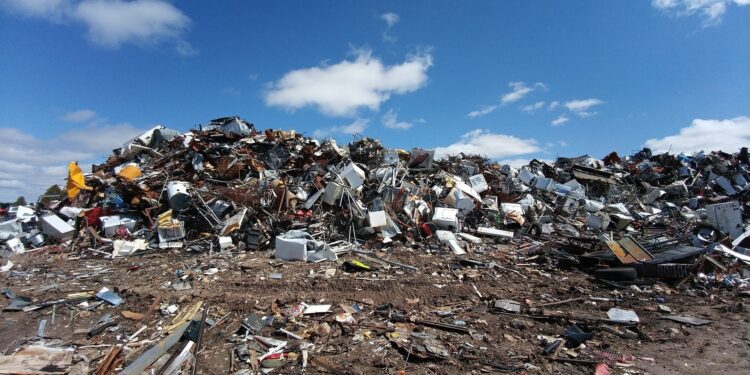Credit: CC0 Public Domain
The world has not curbed its emissions of methane, a powerful driver of climate change. More than 150 countries have committed to reducing their emissions by 30% over the decade as part of a global methane pledge, but new research shows that global methane emissions over the past five years have grown faster than ever.
This trend “cannot continue if we are to maintain a habitable climate,” the researchers write in a September 10 perspective article in Environmental Research Letters published alongside the data in Earth System Scientific DataBoth studies are the work of the Global Carbon Project, an initiative chaired by Stanford University scientist Rob Jackson that tracks greenhouse gas emissions around the world.
Atmospheric methane concentrations are now more than 2.6 times higher than in pre-industrial times, the highest level in at least 800,000 years. Methane emission rates continue to rise, following the most extreme trajectory used in emissions scenarios by the world’s leading climate scientists.
The current trajectory leads to global warming exceeding 3 degrees Celsius or 5 degrees Fahrenheit by the end of the century. “Right now, the goals of the Global Methane Pledge seem as distant as an oasis in the desert,” said Jackson, who is the Michelle and Kevin Douglas Professor at the Stanford Doerr School of Sustainability and lead author of the report. Environmental Research Letters “We all hope that this is not a mirage.”
More methane from fossil fuels, agriculture and waste
Methane is a short-lived but extremely potent greenhouse gas that comes from natural sources like wetlands and from human or “anthropogenic” sources like agriculture, fossil fuels, and landfills. In the first 20 years after its release, methane warms the atmosphere nearly 90 times faster than carbon dioxide, making it a key target for limiting global warming in the near term.
Despite growing government attention to methane, total annual methane emissions have increased by 61 million tonnes, or 20%, over the past two decades, according to the new estimates. The increase is primarily due to growing emissions from coal mining, oil and gas production and use, cattle and sheep farming, and the decomposition of food and organic waste in landfills.
“Only the European Union and perhaps Australia appear to have reduced their methane emissions from human activities over the past two decades,” said Marielle Saunois of the University of Paris-Saclay in France and lead author of the study. Earth System Scientific Data “The largest regional increases were observed in China and Southeast Asia.”
In 2020, the most recent year for which complete data are available, nearly 400 million tonnes, or 65%, of global methane emissions came directly from human activities, with agriculture and waste contributing about two tonnes of methane for every tonne from the fossil fuel industry. Human-caused emissions continued to rise through at least 2023, the researchers said.
Assessment of the impacts of the pandemic
Our atmosphere accumulated nearly 42 million tons of methane in 2020, twice the amount added on average each year during the 2010s and more than six times the increase observed during the first decade of the 2000s.
Pandemic lockdowns in 2020 reduced nitrogen oxide (NO) emissionsx), which generally worsen local air quality, but prevent some methane from accumulating in the atmosphere. The temporary drop in NOx Pollution was responsible for about half of the increase in atmospheric methane concentrations that year, illustrating the complex links between air quality and climate change.
“We’re still trying to understand the full effects of COVID-related lockdowns on the global methane budget,” Jackson said. “COVID has changed almost everything, from fossil fuel use to emissions of other gases that alter the lifetime of methane in the atmosphere.”
Quantifying human influence on methane from wetlands and rivers
Scientists at the Global Carbon Project have made a significant change to their latest accounting of global methane sources and “sinks,” which includes forests and soils that remove and store methane from the atmosphere.
In previous assessments, all methane from wetlands, lakes, ponds and rivers was considered natural. But the new methane budget makes a first attempt to estimate the increasing amount of emissions from these types of sources, which are the result of human influences and activities.
For example, man-made reservoirs release about 30 million tons of methane per year, as newly submerged organic matter releases methane as it decomposes.
“Emissions from reservoirs behind dams are as much a direct human source as methane emissions from a cow or an oil and gas field,” said Jackson, who published a new book on methane and climate solutions called Into the Clear Blue Sky: The Path to Restoring Our Atmosphere (Scribner) in July.
Scientists estimate that about a third of methane emissions from wetlands and freshwater in recent years have been influenced by human-caused factors, including reservoirs and emissions increased by fertilizer runoff, wastewater, land use and rising temperatures.
After a summer where extreme weather and heat waves provided a glimpse of the extremes predicted in climate change, the authors write: “The world has reached the threshold of a 1.5°C increase in global mean surface temperature and is only beginning to feel the full consequences.”
More information:
Robert Jackson et al, Environmental Research Letters (2024). DOI: 10.1088/1748-9326/ad6463
Marielle Saunois et al, Earth System Scientific Data (2024).
Provided by Stanford University
Quote:Methane emissions rising faster than ever, study finds (2024, September 10) retrieved September 10, 2024 from
This document is subject to copyright. Apart from any fair dealing for the purpose of private study or research, no part may be reproduced without written permission. The content is provided for informational purposes only.



